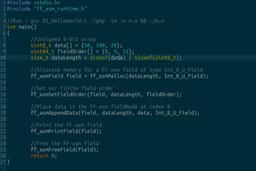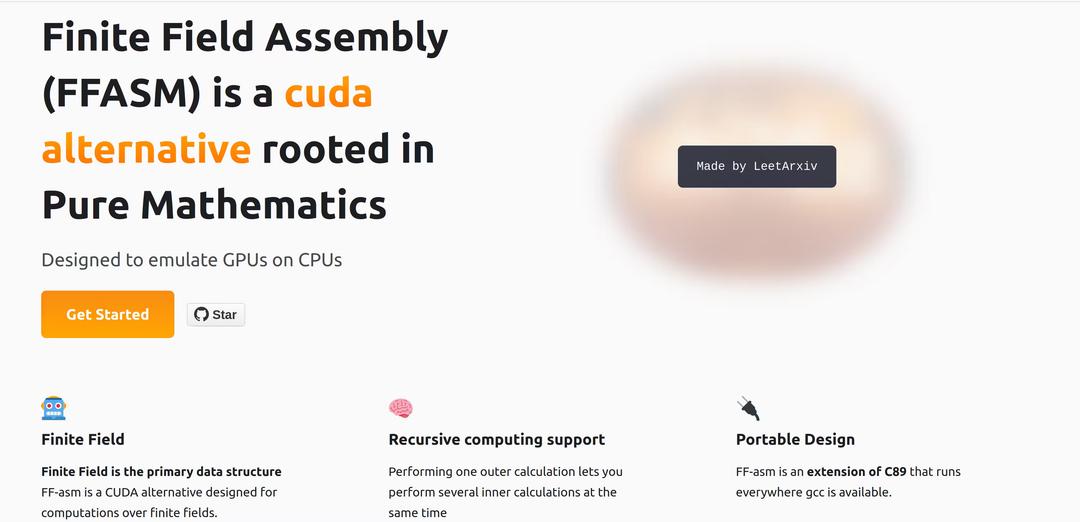
Finite Field Assembly:Emulate GPU on CPU
유한체 어셈블리(FF-asm)는 실제 GPU 하드웨어나 전통적인 병렬화 방법 없이 재귀 계산 및 유한체 수학을 통해 CPU에서 GPU와 유사한 병렬 컴퓨팅 기능을 에뮬레이션하는 저수준 프로그래밍 언어입니다.
https://leetarxiv.substack.com/p/emulating-a-gpu-on-a-cpu-using-finite?ref=aipure&utm_source=aipure

제품 정보
업데이트됨:Jul 16, 2025
Finite Field Assembly:Emulate GPU on CPU 월간 트래픽 동향
제품 유한체 어셈블리: CPU에서 GPU 에뮬레이션의 방문이 4.3% 증가하여 42.3K의 방문을 기록했습니다. 직접적인 제품 업데이트나 주목할만한 시장 활동이 없었음에도 이러한 성장은 일반적인 시장 변동이나 유한체 연산 및 GPU 에뮬레이션 주제에 대한 관심 증가를 반영하는 것으로 보입니다.
Finite Field Assembly:Emulate GPU on CPU이란?
유한체 어셈블리(FF-asm)는 유한체라는 수학적 구조를 통해 일반 CPU에서 GPU와 유사한 병렬 계산을 가능하게 하는 C의 확장입니다. '수학은 대부분 발명되고, 드물게 발견된다'는 주장을 바탕으로 FF-asm은 프로그래머가 계산 문제를 해결하기 위해 자신만의 수학 시스템을 만들 수 있도록 합니다. 전통적인 SIMD 벡터화나 OpenMP 병렬화 루틴에 의존하기보다는 재귀 계산을 구현하여 병렬 컴퓨팅에 대한 독특한 접근 방식을 제공합니다.
Finite Field Assembly:Emulate GPU on CPU의 주요 기능
유한 필드 조합(FF-asm)은 전통적인 SIMD 또는 OpenMP 병렬화를 사용하지 않고 일반 CPU에서 GPU와 유사한 병렬 계산을 가능하게 하는 프로그래밍 언어입니다. 이 언어는 재귀 계산과 유한 필드 수학을 사용하여 단일 계산 내에서 여러 계산을 동시에 수행합니다. 이 언어는 C를 확장하며 프로그래머가 합동식과 소수 이론을 사용하여 사용자 정의 수학 시스템을 생성하여 병렬 처리 기능을 달성할 수 있도록 합니다.
재귀 계산: 다른 계산 내부에서 계산을 재귀적으로 수행하여 전통적인 병렬화 기술 없이 병렬 처리를 가능하게 합니다
사용자 정의 수학 시스템: 프로그래머가 특정 문제를 해결하기 위해 유한 필드를 사용하여 자신만의 수학 구조를 생성할 수 있도록 합니다
C 언어 확장: C에 대한 확장으로 구축되어 친숙한 구문과 메모리 관리를 유지하면서 저수준 제어를 제공합니다
유한 필드 연산: 사용자 정의 필드 차수를 가진 유한 필드에서 기본 산술 연산(덧셈, 곱셈)을 지원합니다
Finite Field Assembly:Emulate GPU on CPU의 사용 사례
고성능 컴퓨팅: 과학 계산을 위한 GPU 하드웨어가 없는 시스템에서 병렬 처리 기능을 가능하게 합니다
암호학: 암호 알고리즘 및 안전한 통신에 필수적인 유한 필드 산술 연산을 구현합니다
행렬 연산: 선형 대수 및 데이터 처리 응용 프로그램을 위한 유한 필드 산술을 사용하여 효율적인 행렬 계산을 수행합니다
장점
전문 하드웨어 없이 병렬 처리를 가능하게 합니다
고급 수학 추상화를 제공합니다
기존 C 코드베이스와 원활하게 통합됩니다
단점
유한 필드 수학에 대한 이해가 필요합니다
특정 유형의 계산 문제에 한정됩니다
네이티브 GPU 구현에 비해 성능 오버헤드가 있을 수 있습니다
Finite Field Assembly:Emulate GPU on CPU 사용 방법
필수 구성 요소 설치: GNU MP Bignum 라이브러리(libgmp)를 설치하고 공식 GitHub 저장소에서 ff_asm_runtime.h 및 ff_asm_primes.h 파일을 가져옵니다.
프로젝트 디렉토리 설정: 새 디렉토리를 만들고 그 안에 ff_asm_runtime.h 및 ff_asm_primes.h 파일을 배치합니다. 이곳이 작업 디렉토리가 됩니다.
Hello World 프로그램 생성: 8비트 부호 없는 정수 유한체를 초기화하는 01_HelloWorld.c라는 파일을 생성합니다. 필요한 헤더를 포함하고 메모리 할당, 필드 순서 설정, 데이터 추가 및 필드 출력 코드를 작성합니다.
컴파일 및 실행: 다음 명령어로 컴파일합니다: gcc 01_HelloWorld.c -lgmp -lm -o m.o && ./m.o
덧셈 구현: ff_asmAdd() 함수를 사용하여 재귀 덧셈 작업을 위한 새 파일을 만듭니다. 이를 통해 재귀 계산을 통해 여러 덧셈을 동시에 수행할 수 있습니다.
곱셈 구현: ff_asmMultiply() 함수를 사용하여 곱셈을 구현하기 위한 또 다른 파일을 만듭니다. 더 큰 결과를 수용할 수 있도록 필드 순서를 늘리도록 합니다.
메모리 관리: 항상 ff_asmMalloc()을 사용하여 필드에 대한 메모리를 할당하고 작업이 끝나면 ff_asmFreeField()를 사용하여 메모리를 해제합니다.
디버그 및 출력: ff_asmDataDebug()를 사용하여 출력할 데이터를 준비하고 ff_asmPrintField()를 사용하여 필드 내용을 표시하고 결과를 확인합니다.
필드 순서 최적화: 계산 요구에 따라 fieldOrder 배열의 필드 순서를 조정합니다 - 더 큰 순서는 더 큰 숫자를 허용하지만 더 많은 메모리를 사용합니다.
Finite Field Assembly:Emulate GPU on CPU 자주 묻는 질문
FF-asm은 수학이 발견되기보다는 주로 발명된다는 아이디어에 기반한 프로그래밍 언어입니다. 이는 프로그래머가 유한 필드를 기본 데이터 구조로 사용하여 자신만의 수학적 시스템을 만들 수 있도록 하는 C의 확장입니다. 주요 특징은 재귀 계산으로, 다른 계산 내에서 계산을 수행합니다.
Finite Field Assembly:Emulate GPU on CPU 웹사이트 분석
Finite Field Assembly:Emulate GPU on CPU 트래픽 및 순위
42.3K
월간 방문자 수
-
전 세계 순위
-
카테고리 순위
트래픽 트렌드: Dec 2024-Jun 2025
Finite Field Assembly:Emulate GPU on CPU 사용자 인사이트
00:02:15
평균 방문 시간
1.4
방문당 페이지 수
73.05%
사용자 이탈률
Finite Field Assembly:Emulate GPU on CPU의 상위 지역
US: 61.31%
CN: 8.36%
GB: 8.06%
HK: 6.37%
CZ: 6.12%
Others: 9.79%











